- Skip to main content
- Skip to primary sidebar

Wilderness Inquiry
Share the adventure!

We're happy to answer any questions you have!
- Name * First Last
- Comment or Question(s)? *
- Subscribe to News and Updates
- Are you a robot?
- Name This field is for validation purposes and should be left unchanged.

Boundary Waters Canoe Area
Paddle million-acre wilderness.
The Boundary Waters Canoe Area Wilderness is America’s premier canoe destination. It is also one of the most accessible wilderness areas in the United States, and where Wilderness Inquiry began operating in the 1970s. Over one million acres in size, the Boundary Waters covers much of the Superior National Forest in northeastern Minnesota. Paddle among towering pines in the home of moose, lynx, wolves, and bald eagles.
Every Wilderness Inquiry trip ensures your adventure is the best it can be. Decades of experience in combination with top notch food and gear make Wilderness Inquiry BWCA trips an exceptional value. Our classic 5-day Boundary Waters Canoe Area Paddle Adventure is the quintessential guided canoe trip . Paddle lightweight Wenonah kevlar canoes and camp in beautiful lakeside campsites. The Boundary Waters lodge based adventure is based out of stunning Wintergreen Lodge on White Iron Lake. From here, you’ll enjoy excellent BWCA day trips off the Kawishiwi River or the Fernberg Trail, returning to delicious meals, a glass of wine, and a comfortable bed at night. The Boundary Waters Family Canoe and Hike trip is geared for families and based at a Forest Service campsite, allowing us to do day trips in smaller groups into the Wilderness. Our Boundary Waters Winter Adventure changes it up for winter fun at Camp Menogyn on West Bearskin Lake. You will love dogsledding, skiing, and seeing the Wilderness dressed in its winter clothes.
Whatever Boundary Waters trip you choose, we know you will enjoy this iconic wilderness area and come to understand why it is beloved by so many.
View by Itinerary
View by date.
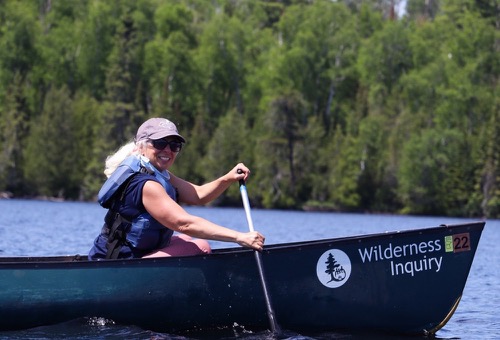
Boundary Waters Canoe Area Paddle Adventure
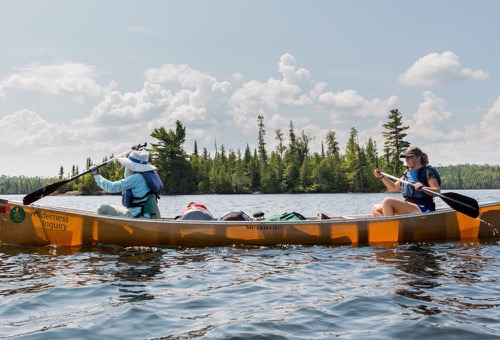
Boundary Waters Base Camp Adventure
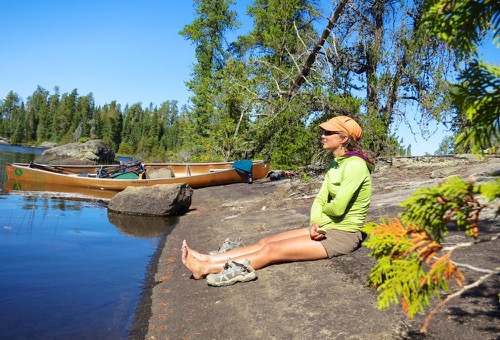
Boundary Waters Canoe Area Expedition
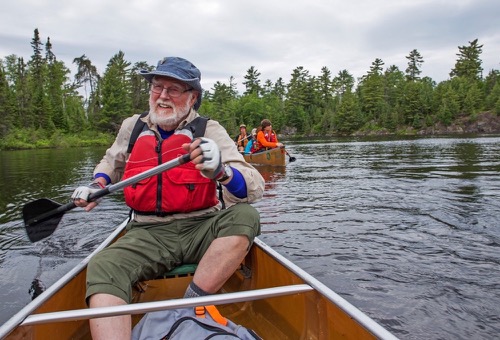
Boundary Waters Lodge-Based Adventure
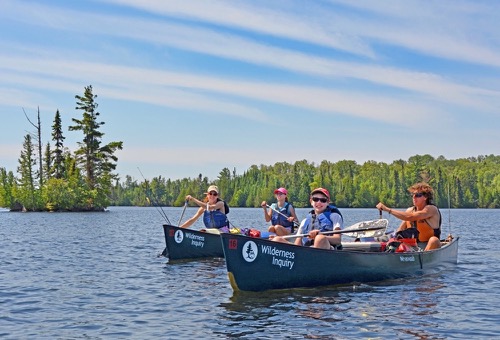
Boundary Waters Family Canoe and Hike
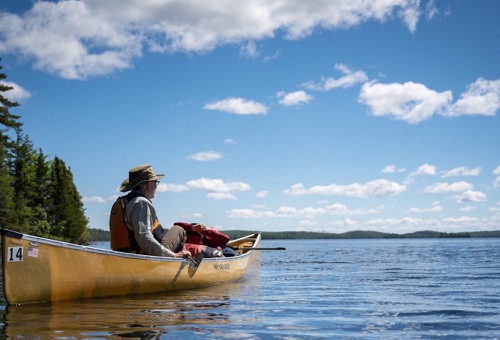
Boundary Waters Lodge-Based Reader’s Retreat with William Kent Krueger
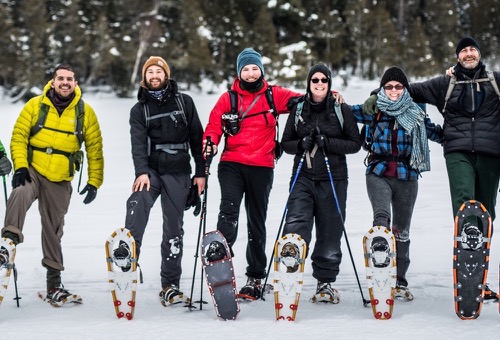
Boundary Waters Winter Adventure
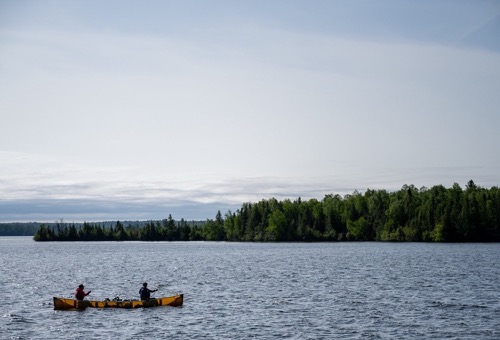
Boundary Waters Base Camp: Potlikker and Smoke with Chef Lachelle
About the area.
In 1964, Congress designated the BWCA as one of the first federally protected wilderness areas in the United States as part of the National Wilderness Preservation System. The BWCA, the northern third of Superior National Forest, lies on the international border between northern Minnesota and the Province of Ontario, Canada. Together, with the adjoining 1.2 million-acre Quetico Provincial Park on the Ontario side of the border, this international wilderness complex forms an unparalleled lakeland complex of 2.3 million acres, an area larger than Yellowstone.
Sculpted by glaciation, the area is part of the Canadian Shield, a geological formation that comprises portions of the earth’s most ancient exposed rock, some of which is 3 billion years old! The Boundary Waters contains about 1,175 lakes in all, creating a maze of interconnected wilderness waterways to explore. Whether you paddle one of the larger border lakes – Saganaga, Knife, Basswood, Crooked, Lac La Croix – or one of the smaller more intimate lakes, you’ll experience an undeveloped wilderness that appears much the same as it has for hundreds of years. Each lake brings its own distinct personality and you may find you and your canoeing partners each have a different favorite.
Two types of forests, the Boreal and Laurentian forests, converge to create a unique ecosystem with diverse plant and animal life in the Boundary Waters. Animals that would not normally be seen together, such as the white-tailed deer and the moose, have made the BWCA their homes. Many birds, such as bald eagles & loons, and over 20 species of wood warblers, use the Boundary Waters as their nesting grounds. Anglers can test their skills against the area’s lake trout, walleye, northern pike, or small and largemouth bass.
Humans have left their mark on the Boundary Waters as well. Native peoples inhabited the Boundary Waters area for thousands of years, with some human relics dating back to 10,000 BC. The Anishinabe (sometimes called Ojibwe, or Chippewa) and Dakota (Sioux) used the intricate waterways of the BWCA for hundreds of years. Native peoples first used many of the campsites and portages (paths between lakes) still used today. Artifacts from that period can still be found on occasion. European fur traders and missionaries first came into the area in the early 1700s. A working relationship developed between the European fur traders and the Ojibwe, based on trade of European goods for native knowledge and furs. This partnership ended in the mid 19th century due to the declining interest in furs as fashion.
Fur trading and logging of the Boundary Waters began taking its toll on the fragile ecosystem. People decided to act, setting aside this pristine area and working to protect it from further harm. In 1909, President Teddy Roosevelt established the Superior National Forest, with 1,000 square miles of roadless land (the precursor to the BWCA) later set aside in 1926 as the nation’s second administratively-established wilderness. The 1964 Wilderness Act designated the Boundary Waters as an original unit of the National Wilderness Preservation System, but with some compromises that allowed logging and motorboats to continue there. Congress passed additional protections for the BWCA in 1978, and expanded the area to its current borders and size of 1.1 million acres. The controversy surrounding this Congressional effort for the Boundary Waters also led to the establishment of Wilderness Inquiry; WI began by taking canoe trips in the BWCA and continues doing so to this day.
The Boundary Waters is one of National Geographic Traveler magazine’s “50 Places of a Lifetime.” Situated within Superior National Forest in northeastern Minnesota, the Boundary Waters Canoe Area Wilderness is a vast preserve of lakes and woods that stretches for about 100 miles along the U.S. border with Canada. Spread within the Boundary Waters are over 1,500 miles of canoe routes over more than 1,000 lakes, rivers and streams linked by trails called “portages.”
Due to strict permitting and non-motorized status the wilderness is yours to explore without people or vehicles. These factors contribute to the serenity of the area creating the perfect location for canoeing.
Camping for families
The wilderness is and ideal setting for families. Without the noise of daily life expect to learn more about yourselves and each other. The Boundary Waters Family Canoe and Hike trip is geared for families and based at a Forest Service campsite, allowing us to do day trips in smaller groups into the Wilderness.
Adventurers
Our classic 5-day Boundary Waters Canoe Area Paddle Adventure is the quintessential guided canoe trip for adventurers of all ability levels. Our experienced guides will teach you basic paddle strokes, the art of portaging a canoe, and can help you find a new appreciation for the great Northwoods.
- Plan A Canoe Trip
- Full Outfitting
- Canoe Rental & Partial Outfitting
- Permits, RABC, & Other Forms
- Guided Canoe Trips
- Piragis Guided Group Trips
- Canoe Trip Menu
- Scouts & Organizations
- Satellite Phones and SPOT Texting Devices
- Fly In Trips, Shuttles, & Tows
- Used Equipment For Sale
- Winter Rentals and Guides
- Canoe Trip Packing List
- Why Choose Piragis Outfitting?
- What is the Boundary Waters?
- Boundary Waters vs Quetico
- Quetico Information
- What is a Canoe Trip?
- Why Wilderness Matters
- Seasons of the Ely Area
- Average Ely Area Weather
- Pictographs
- Other Area Activities
- Boundary Waters Fishing
- Wenonah Canoes
- Northstar Canoes
- Delta Kayaks
- Perception Kayaks
- Wilderness Systems Kayaks
- Pakboats (Folding Canoes & Kayaks)
- Used Canoes, Kayaks & SUPs
- Canoe Repair
- In Stock New Canoes
- Winter Rentals
Guided Trips
Guided boundary waters canoe trips and tours, ely mn.
Looking for the best experience the Boundary Waters has to offer? Take one of our wilderness guides along. Their knowledge and passion are contagious. They’ll help you get the most out of your wilderness adventure and teach you the skills necessary for future Boundary Waters trips.
Whether you are planning on a day trip, short overnight trip, or a longer adventure, our guides are available to accommodate your needs. We are flexible and fully customizable. See all our exciting trip options below.
Contact Drew, Adam, or Tim Barton with questions:

Guided Camping Trips
Personalized guided canoe camping trip. Bring your family and friends for the adventure of a lifetime.

Guided Day Trips
Spend the day in the BWCAW with one of our expert guides. See the sights and enjoy the wilderness. Don’t forget your camera.

Guided Group Trips
Sign up for one of our themed guided trips. Meet new friends from all over the country and enjoy this wonderful wilderness.

Guided Fishing Trips
Looking for lunkers? Bring one of our expert guides along for the fishing experience of a lifetime. Day trips and overnight trips available.
Prove It First: Commonsense Protection For The Boundary Waters & Lake Superior. Take Action
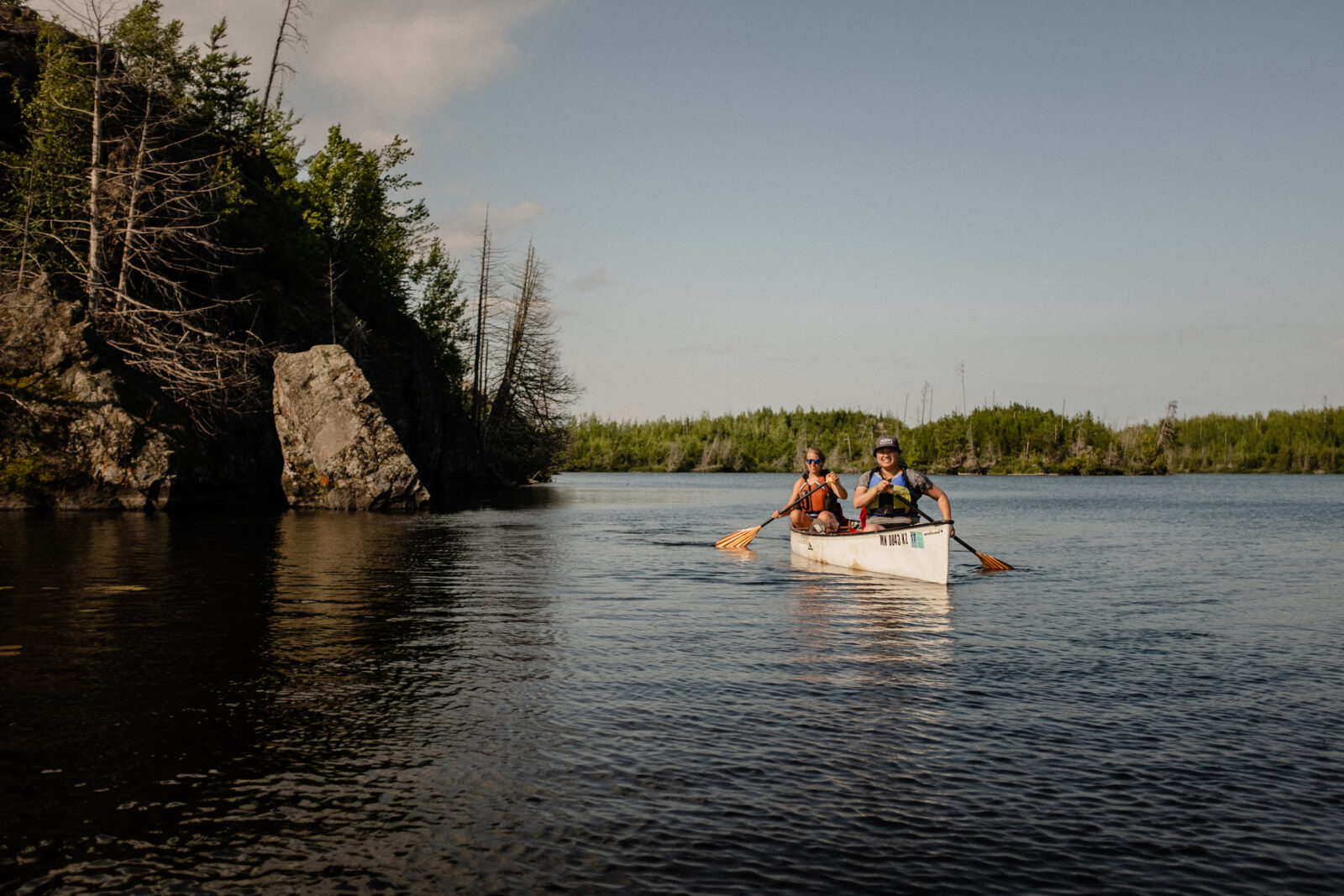
Plan a Boundary Waters Trip
Need inspiration for your next adventure? Want to canoe the Boundary Waters but not sure where to begin? You’ve come to the right place!
Decide What Type of Trip to Take
There are many ways to explore the Boundary Waters, but the two most popular modes of travel are hiking and canoeing.
Northeastern Minnesota is created for canoeing. This is the best canoe country in the United States, a place where each year thousands of lives are transformed.
A number of rugged wilderness trails wind through canoe country, challenging the stamina and navigational skills of even seasoned backpackers.
Pick a Time of Year
From Memorial Day through Labor Day, the Boundary Waters becomes a destination for adventure seekers and those looking to relax, fish, and discover the wonder of this national treasure.
Crisp weather, stunning colors, fewer people and no bugs. There’s a reason people pick fall to get their Boundary Waters fix!
Once the lakes freeze, people exchange their paddles and canoes for snowshoes and dogsleds. Those who embrace the cold are rewarded by unmatched beauty, silence and wonder.
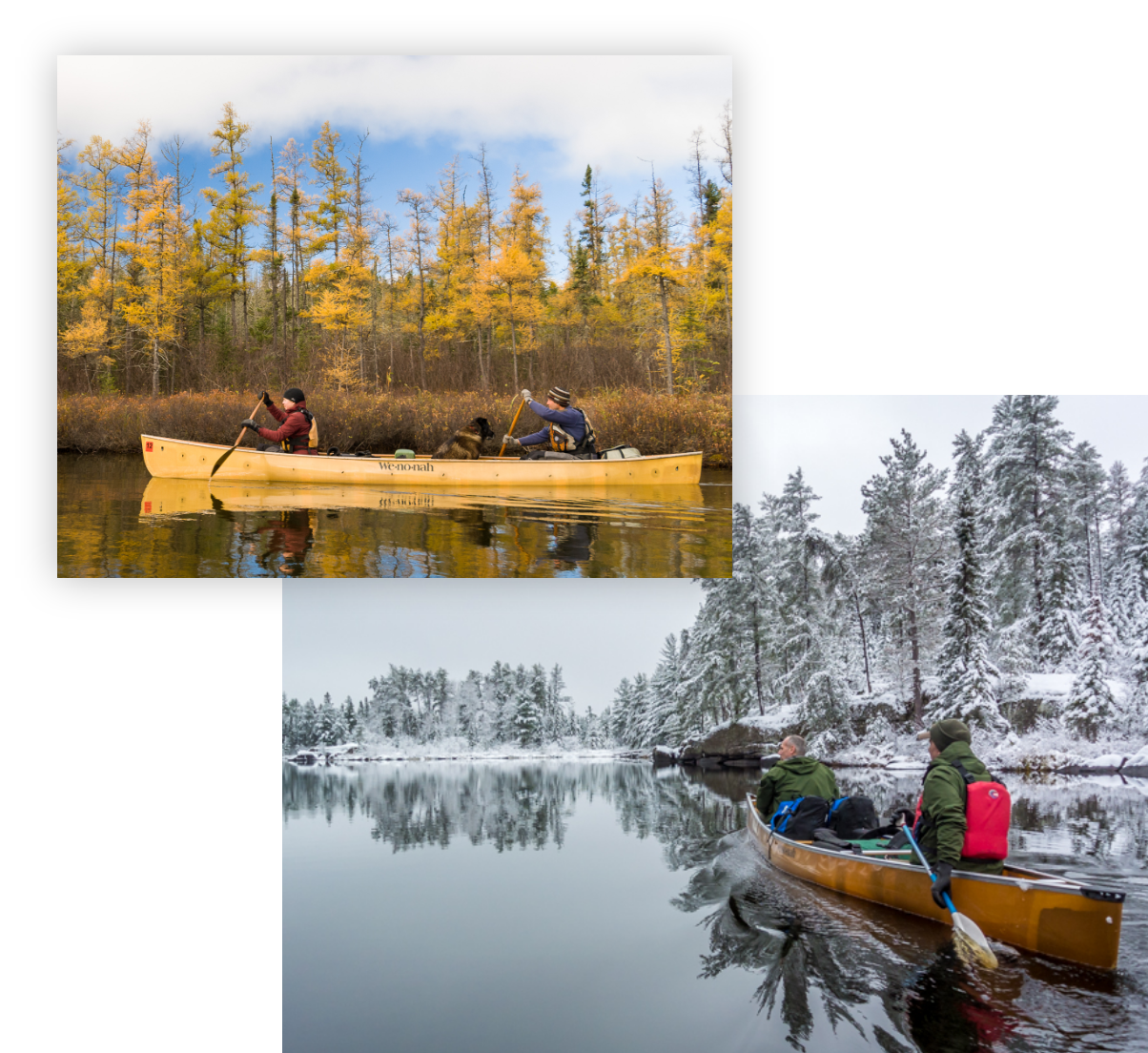
Select Your Route
Our interactive route-finding tool makes it easy to find your next adventure. With 1,200 miles of canoe routes and endless options of where to go, what lakes to visit and which portages to take, you’ll need a couple lifetime’s worth of paddling before you get bored.
Reserve Your Permit
From May 1 to September 30, if you plan on any kind of overnight visit to the Boundary Water (backpacking, canoeing or otherwise) you need to obtain a quota permit. They go quickly, so reserve yours in advance!
Continue Preparing for Your Boundary Waters Trip

Visit an Outstanding Outfitter.
Used Outfitting Equipment For Sale
Help Wanted - Employment Listings
Canadian RABC Application for Quetico Park
Quetico Park/North Side Canoe Outfitters - Ontario Canada
Call us: 218-365-5581
Tips On BWCA Canoe Trip Routes
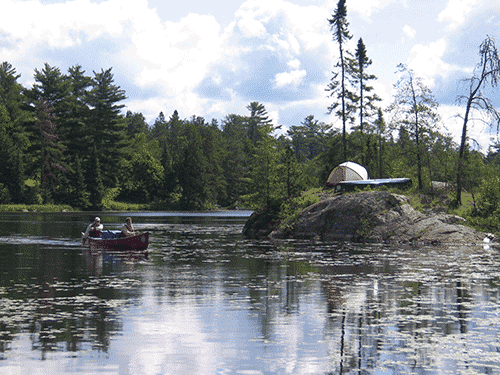
Your trip through the wilderness will only be as good — or as bad — as the route you travel. There is no one route that is best, and there is no one entry point that is best. BWCA Routes can change a great deal over the course of a summer.
Considerations in picking a route
- Your personal preferences on the number of times you would like to change campsites play a major consideration. A party wanting to be out for five days and have four campsites would obviously travel farther than one want to be out seven days, but only want two campsites.
- From mid-May thru early June, some portages may be muddy.
- In August, some of the smaller rivers drop to a point where whole sections might have to be walked because there isn’t enough water to float a loaded canoe.
- Some lakes have different kinds of fish than others.
- The bug situation of June and July varies from one section to another.
- Forest fires are a natural part of the wilderness ecosystem. However, it takes a season or two for an area to start to green-up after a fire. Blackened areas might want to be avoided.
- Some areas may have bans on open fires . North Country provides stoves with our complete outfitting, so cooking would not be impacted. But as for the evening campfire … the answer would be NO. If having an evening campfire is important to your party, picking another area would probably be wise.
We know what those differences are, and are prepared to offer our suggestions so your trip can match your expectations .
The ability level of your party as a whole must be considered. If your participants have had a lot of time in canoes prior to arriving in Ely, they will travel farther each day than a group who has only had canoe experience in their city park. How well does everyone work together? Can meals be cooked in 15-20 minutes, or is it an all evening chore?
Obviously, a group that has only five days to spend in the woods will not have the same route as one having 7-10 days. We want to know how many campsites you will want to be in. On a 6 day/5 night trip you can have as many as five different sites, or you may choose travel every other day using 3 sites, or even set up a base camp and take day-trips from your one location.
Remember, every time you take down and set up another campsite, you are pulling about three hours of your day that you could have been doing something else. Also, on day trips you can travel farther and faster since you are not taking equipment across the portages.
Long-time NCCO Customers Scott & Nicole Sims talk about their experience:
Boundary Waters Canoe Area Wilderness Guide
The Boundary Waters Canoe Area Wilderness (BWCAW) covers 1 million acres with over 1,100 lakes, along the Minnesota-Canada border. Since 1978 and the passage of the BWCA Wilderness Act, these lands have been designated “an area where the earth and its community of life are untrammeled by man, where man himself is a visitor who does not remain.” With 200,000 visitors a year the BWCAW is the most popular wilderness area in the country! There are 59 paddling entry points between Cook , Ely , Tofte, Isabella , and Grand Marais to begin your canoeing adventures. Check out our popular interactive BWCAW Entry Point Map and scroll down for Park Information.
Explore Canoe Trip Services:
• Ely • Grand Marais • Tofte and Isabella • Orr/Crane Lake • Cook
Park & Permit Info
Entry point reservations and rules & regulations:.
BWCAW Trip Planning Guide [pdf]
BWCAW Online Reservations/Permits
The BWCAW rules and regulations are designed to retain the area’s “wilderness character,” as stated in the 1978 BWCA Wilderness Act. The park is managed by the United States Forest Service as part of the Superior National Forest, whose headquarters are in Duluth with ranger stations in towns across northeastern Minnesota. Motorized watercraft are prohibited except for day-use on a few large lakes around the park’s boundaries. Camping is only allowed at designated sites that have a pit-toilet and a fire grate. To reduce visitors’ environmental footprint they are asked to uphold the Leave No Trace guidelines and groups are capped at 9 people and 4 watercraft.
Human impact in the BWCAW is also moderated by requiring visitors to have a permit. There are several permit varieties depending on what time of year you go and what sort of trip you take: From May 1 to September 30, all overnight stays and motorized day-use require quota permits, but self-issued permits are available for non-motorized day-use. From October 1 to April 30, all permits are self-issued for either day or overnight use. Quota permits should be reserved ahead of time, and then picked up at Forest Service stations or a cooperating organization, such as an outfitter. Self-issued permits do not require any reservation and can be obtained at Forest Service stations, some BWCAW trailheads, and through the mail.
Another result of the permit system is that visitors are encouraged to travel to new places within the wilderness area. Reservations require forethought and invite canoeists to look at entry points all across the map.
The Friends’ Guide to the Boundary Waters
www.recreation.gov
Leave No Trace Superior National Forest
Fire Information
The use of campfires in the BWCAW is more controlled than in other popular canoeing areas due to the massive blow down of trees in the forest that occurred on July 4, 1999. Since that event, the U.S. Forest Service, which manages the wilderness, has attempted to moderate wildfire risk with controlled burning. Recent wildfires have also reduced the fuel load.
Paddlers in the BWCAW are advised to keep abreast of wildfire conditions via the USFS BWCAW web site . Paddlers can plan trips using this USFS map which outlines restricted and unrestricted fire areas in the wilderness. As always, visitors are encouraged to use gas or propane cook stoves to reduce impacts to the wilderness.
MN DNR: Current Fire Restrictions
Maps & Routes
The most commonly used maps for paddling in the BWCAW are those produced by W. A. Fisher Maps and Publications and McKenzie Maps. The maps mark and measure portages, denote campsites, and include topographical contours. The U.S. Forest Service produces a map of the entire Superior National Forest that, while impractical for trip navigation, can help in selecting entry points and planning trips.
The network of lakes, rivers, and portages in the BWCAW creates an infinite combination of routes. Adventurous paddlers can pick an entry point and travel routes to match the time and energy they have to spend. Some basic routes, each launching from the region of a different permit-granting ranger station, are listed below.
Popular Boundary Waters Canoe Routes:
Seagull Lake – Alpine Lake – Red Rock Lake – Saganaga Lake – Seagull River – Gull Lake 1-2 Days, Easy to Moderate Explore the effects of fire on the Boundary Waters on this canoe route. Read More >
Rose Lake Weekender (Gunflint Ranger Station) 2-4 Days, Easy Paddlers short on time or in the mood for a quick, easy trip should consider picturesque Rose Lake. From the launch on Bearskin Lake, it’s just two portages to this lovely border lake. A base-camp on Rose is nicely positioned for a day-trip to the Height of Land Portage between North and South Lakes–the drainage divide between waters flowing to Lake Superior and the Atlantic Ocean and those going north to Hudson Bay. In the voyageur era, travelers who crossed this portage heading north earned the title “Men of the North” and the honored status that went with it.
Sawbill–Long Island–Winchell Lake Loop (Tofte Ranger Station) 6 Days, Difficult With a week to commit to canoe and paddle, trippers can circle a large swath of the eastern BWCA with this route. Heading north from the Sawbill Lake entry point, venture out through Cherokee Lake toward Long Island Lake. From there, you can follow either of two routes to lovely Winchell Lake. From Winchell, head south to massive Brule Lake, but plan extra time in case the winds are unfavorable. From Brule, head back to Sawbill via Knife and Jack, Burnt and Smoke Lakes. The trip includes big lakes and sinuous creeks. There are some long portages and you’ll be covering a lot of ground, but if you’re ready for the trip you’ll be well rewarded.
The Sawbill Lake Outfitters website describes in detail eleven trips to do in the area.
Bald Eagle–Kawishiwi River–Lake Three (Isabella Ranger Station) 4-6 Days, Moderate From your entry point at Snake Creek which flows into Bald Eagle Lake, you can loop to the northwest via Gabbro Lake and the Kawishiwi River. From the “Kawish,” you can work your way east through the “Number Lakes”–Lake One, Lake Two, and Lake Three. You can extend your trip through, yep, Lake Four toward, nope, Lake Insula, but you’ll need to backtrack to return. (A base-camp on Lake Four, however, offers two nice day-tripping loops to the north and south.) To get back home, portage to Rock of Ages Lake from Lake Two and then from Clearwater Lake return to your entry point via Pietro and Gull Lakes.
Mudro–Fourtown–Basswood River–Crooked–Angleworm (Kawishiwi Ranger Station, Ely) 6 Day, Difficult This classic BWCAW trip features pictographs, waterfalls, and time spent paddling along the international border. Start at Mudro Lake (but leave a second vehicle at nearby Hegman Lake) and paddle through Fourtown and Horse Lakes and down the Horse River to Lower Basswood Falls. After enjoying and portaging the falls, admire the pictographs downstream made famous in the Francis Lee Jacques painting. (Or camp within evening paddling distance of Wheelbarrow and Upper Basswood Falls.) From there, follow the river to Crooked Lake. If you want to see one more waterfall, paddle beyond Friday Bay on a day-trip to admire Curtain Falls at the outlet of Crooked Lake. Otherwise, portage out of the lake at the bottom of Friday Bay toward Angleworm Lake. From Angleworm there’s a 460-rod portage to get home, but you should be fit and your food pack light by now. At Hegman Lake, you’ll be rewarded for your efforts by the lake’s famous set of pictographs.
Moose River–Lake Agnes–Lac la Croix (LaCroix Ranger Station, Cook) 6 Days, Moderate Here’s another BWCAW classic: Follow the Moose River north to Nina Moose Lake and Lake Agnes. Then follow the Boulder River North into Lac la Croix. (As an alternative, you can take the less traveled Stuart River–and its 480-rod portage–to reach Stuart Lake, and then follow the lovely Dahlgren River to Lac la Croix.) On Lac la Croix you’ll find two of the landmarks of Quetico Superior country–the Lac la Croix pictographs and Warrior Hill. Off Iron Lake to the east you can enjoy Rebecca and Curtain Falls. You can lengthen the trip and avoid back-tracking by paddling west through Lac la Croix’s Fish Stake Narrows to Pocket Creek and then returning south through Ge-be-on-e-quet, Green, Rocky, and Oyster Lakes back to Agnes.
W. A. Fisher Maps
McKenzie Maps
Voyageur Maps
BWCAW Maps at ShopCanoeing.com
The BWCAW as we know it today was born with the Boundary Waters Canoe Area Wilderness Act of 1978. But a long, often contentious, history brought events to that point. The Shipstead-Newton-Nolan Act of 1930, the first federal law to order the setting aside of lands for wilderness, effectively ended Edward Backus’ plans to impound waters in the area for industrial hydropower. The Wilderness Act of 1964 established the current wilderness preservation system in the country. The next year, a new management plan for the Boundary Waters required permits to enter the wilderness. In 1971 designated campsites were instituted on heavily used lakes. In 1975 designated campsites were made a wilderness-wide rule and allowable group sizes were lowered from 15 to 10 persons. Despite Representative James Oberstar’s bill to establish a Boundary Waters Wilderness Area of 625,000 acres and a Boundary Waters National Recreation Area of 527,000 acres where logging and mechanized travel would be allowed–including on Lac la Croix, Basswood, Saganaga, and Seagull Lakes–the Boundary Waters Act was passed in 1978. Since then, wilderness and multiple use proponents have often used the courts to clash over interpretations of the Act.
History of the Quetico Superior Region
Superior National Forest
Like Quetico Provinicial Park to the north, evidence of the last glaciation in the area sets the stage for the natural world of the BWCAW. The exposed Pre-Cambrian bedrock–smoothed, rounded, scratched, and cracked by the ice–provides the foundation for the wild plant and animal life of the wilderness, where wolves follow moose beneath towering pines.
The BWCAW forest–at the transition zone between mixed hardwoods of the Lake Superior region and the confers of the farther north–is composed of coniferous species like the white, red, and jack pine, the black spruce and deciduous trees like aspen and birch.
Large mammals living in the forest include the moose, white-tailed deer, and their prime predator, the timber wolf. The omnivorous black bear haunts the landscape and a campsite or two. Beavers paddle the ponds. Small mammals include the snowshoe hare, the eastern chipmunk and the red squirrel.
The area boasts 250 species of birds from the soaring eagles and ospreys to flitting warblers and flycatchers. The hoot of the Barred Owl and the call of the Common Loon provide the background music for the landscape.
Friends of the Boundary Waters Wilderness
The BWCAW is known for its wide variety of fishing opportunities. In the deeper lakes, many of them in the northeast of the wilderness, lake trout are the most sought-after species. Lake trout, found in deep water once the weather and lake temperatures warm, can be found in shallow water in the spring and early fall.
Northern and walleye pike are present in most of the lake of the region, with the latter providing the main course of many a BWCAW shore-lunch. Northern pike are the easiest to catch as this major predator is one to strike first and ask questions later when it comes to your lure. In selected lakes, anglers can find small-mouthed bass. Small-mouth fishing is best in the late-spring and early summer.
Minnesota DNR: Fishing
Remote Border Crossing
The BWCAW and Quetico Provincial Park meet along the border between Canada and the United States. Canoeists can paddle across the border, but while the wilderness is contiguous, park management and government regulations are not. Understanding the rules ahead of time will ease your remote border crossing process.
Entering the United States
Whether you drive or paddle into the U.S. you must have the proper government-issued identifcation on hand.
U.S. citizens entering the U.S. at sea and land ports of entry must have a passport, passport card, or compliant document. Canadian citizens must present a valid passport or other approved document. For more information visit U.S. Travel.State.Gov
Paddling Into the BWCAW from Canada
If your canoe trip starts in Canada and you paddle into the BWCAW from Quetico or the Crown Lands, you must apply for BWCAW permit entry #71. You are also required to report to a U.S. Customs Border Protection officer for inspection at the end of your trip. You can report to inspection locations in Grand Portage, Grand Marais, Crane Lake and Ely. To learn more, call Customs directly at 218-475-2244.
Canoe trips that originate in the BWCA, pass into Canada and then return to the BWCAW do not require Permit #71. Re-entry into the BWCAW is covered by the permit for their original point of entry.
Paddling Into Quetico from the U.S.
Different regulations apply for paddling across the international border into Quetico Provincial Park. Learn More >
CANPASS Remote Area Border Crossing (RABC)
U.S. Travel.State.Gov
U.S. Customs and Border Control
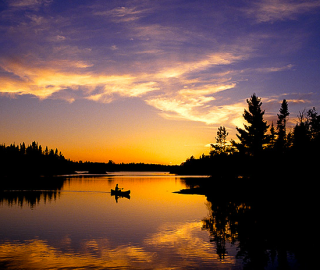
Boundary Waters Canoe Area Wilderness (BWCAW) Guide
Bwcaw jump-off points:.
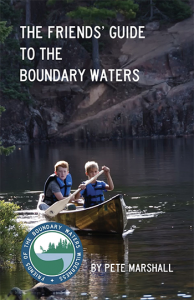
Video Trip Log: BWCA 4 Day Trip

BWCA Fall 2020 Moose Lake Loop ”Intense Paddle“

The Saga Continues

First Overnight in the BWCA

Boundary Waters Canoe Area Wilderness: Modified Kawisihiwi Lake/Lady Loop

• Disclaimer and Use Policy
https://tigaprediksi.com/
https://armynavysuperstores.com/
https://dutawarta.com/
https://woaynews.com/
https://pupwb.org/
https://haraznews.com/
https://toysmatrix.com/wp-includes/slot-gacor/
https://girimenangnews.com/
https://geprekbensuindonesia.com/
https://everythinginclick.com/wp-content/uploads/slot-bonus/
https://caraslot.com/wp-includes/slot-bonus/
https://www.casablancahire.com/blogs/wp-includes/slot-bonus/
https://www.genesiscalbeautystudio.com/wp-includes/slot-bonus /
https://www.hookdonthehudson.com/
https://bimbelruangprestasi.com/wp-includes/slot-bonus/
https://thenews100.com/
https://expertautokool.ee/wp-includes/slot-bonus/
https://www.padslakecounty.org/wp-content/uploads/rekomendasi-situs-slot-gacor-gampang-menang/


Compare items
- Total ( 0 )

How to Plan a Boundary Waters Canoe Trip in Minnesota
Start planning your Minnesota Boundary Waters canoe trip with this complete guide including BWCA entry points, Boundary Water camping, & more

Planning a Boundary Waters canoe trip in the Boundary Waters Canoe Area Wilderness (BWCA) involves navigating a labyrinth of over 1,000 lakes and islands. Located on the Minnesota/Canada border, I’ve made countless trips to the BWCA ever since I was a kid and it always delivers when I want a quiet week filled with great views and adventure.
The BWCA is the most-visited wilderness area in the U.S. and for good reason. From short overnight trips to multi-week remote adventures, the BWCA offers a unique camping experience for all skill levels. Like most remote camping trips, though, canoeing the BWCA requires planning in order to secure permits, learn how to navigate lakes and make portages, and assemble the right gear for a successful trip. I’ve made many trips to the BWCA, so in this post, I’m sharing all the important tips and guidance you’ll need to have a successful trip in Minnesota’s great north woods.
In this Boundary Waters canoe trip guide, I share everything you need to know to plan your own canoeing adventure to this amazing and remote area.
Important Reminder: As outdoor recreationists, it’s our responsibility to know how to recreate responsibly on the water whether we’re kayaking, paddleboarding, canoeing, rafting, or boating. Learn how to prevent the spread of aquatic invasive species with 3 easy steps that have a huge impact on our ecosystems.
Best Time to Canoe the Boundary Waters
Since the lakes freeze over in the winter, the best time to canoe the Boundary Waters is between spring, summer, and fall. Typically May through October is the canoeing season.
The summer months are the popular time to go, especially the back half of August. The water is warm enough to swim in and the weather gets up into the 70s and 80s. The main downside to canoeing in the summer months, however, is that mosquitoes and biting flies can put a huge damper on your trip. Bugs peak in mid-June and while the black flies last a week or two, the mosquitos stick around all summer. People share horror stories about the mosquitos, but truthfully they’re not much different than anywhere else in the Midwest.
Visiting during the spring is constrained to the month of May since the lake ice usually doesn’t melt until then. It’s a great month for fishing, solitude, and returning animals and birds, but it can be cold — lows are typically in the 40s.
Fall is one of the best times to visit the BWCA. There are fewer or no bugs, the crowds are basically gone, the fish are returning to the shallow water, and the fall colors are changing. Camping from mid-September to mid-October is the best time to visit if you want to catch the fall foliage as the aspen, birch, and maples leaves begin turning red, orange, and yellow. Make sure to check out these fall camping tips if you plan to visit during this season.
No matter what time of year you visit, it’s important to be prepared for cold temperatures, rainy weather, or submerged and wet gear. Always pack extra warm layers and don’t use cotton.

Planning Your BWCA Route
Bwca entry points.
There are two main BWCA entry points to start your trip: Ely and the Gunflint Trail . In general, the Ely area is quite wooded and has old-growth tree stands you can camp near. Visitors starting in the Gunflint area are likely to see the effects of fires and blowdowns, but while some forests in this area seem more sparse, there’s a more remote, rugged quality to this terrain.
I’ve done a handful of canoe trips out of Ely, but I prefer the Gunflint area for starting a trip because you immediately enter into wilderness with a rugged character.
BWCA Portages
If you’ve never been to the Boundary Waters before, it’s possible you’ve never had to portage a canoe before. Simply put, a portage is when you pick your canoe up and move it overland from one lake to another. The BWCA has over 1,000 lakes connected by portage paths of varying lengths — the shorter and fewer of them on your route, the easier it will be.
Portages are typically measured in rods, which is 16.5 feet long, roughly the length of your canoe. Portaging a canoe isn’t as hard as it seems and it’s actually easy to pick up and carry a canoe by yourself. It has more to do with skill than strength — forget the methods that have you quickly lift the canoe overhead like a powerlifter. Simply follow this method for picking up and carrying the canoe . I’ve seen retired folks do this in the BWCA with no problem at all.
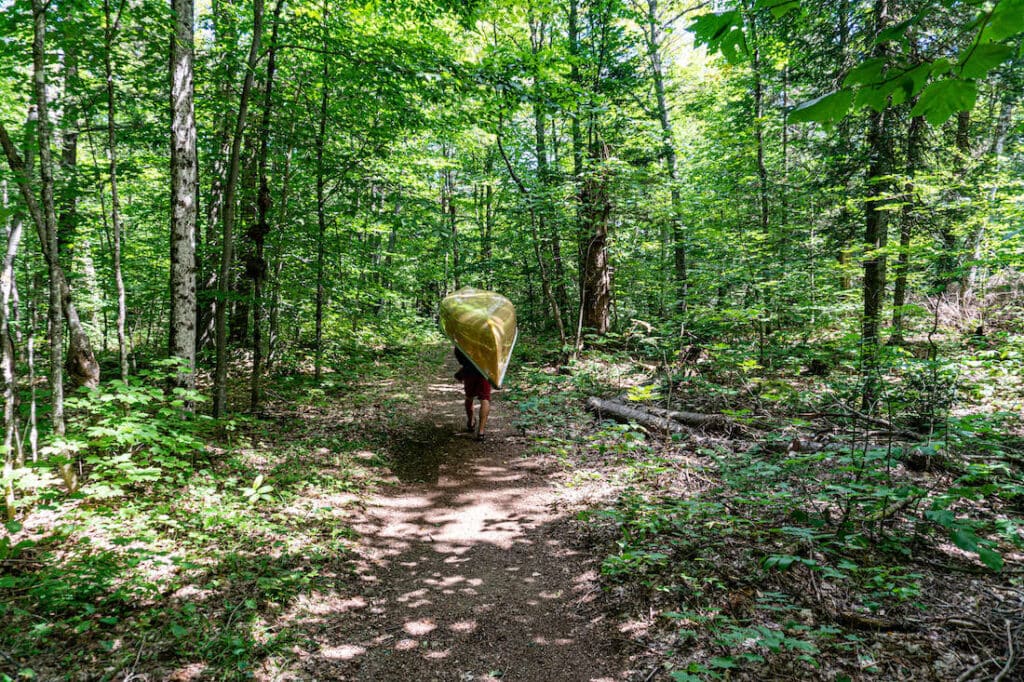
Boundary Waters Route Options
My favorite BWCA route is starting off at the Gunflint Trail at Saganaga Lake and canoeing to Red Rock Lake, Alpine Lake, and Sea Gull Lake to loop back to the start.
There are lots of different route options, though, and you can’t go wrong using the Trip Planner from the Friends of the Boundary Waters Wilderness (more on them later) to cater the route to your trip. You can choose different routes depending on your timeframe, how many portages you’d like to take, how long you want to paddle each day, and your current skill level.
Boundary Waters canoe rentals & Outfitters
While some people bring their own canoes to the BWCA, there are plenty of Boundary Waters canoe rental outfitters in both Ely and the Gunflint Trail. Not only are they inexpensive, but the guides here are a wealth of knowledge for planning your trip, asking questions, and getting some great beta on the best swimming spots and fishing holes. I’ve had great experiences with Voyageur Canoe Outfitters .
Keep in mind that the BWCA is a very large wilderness area, and with so many lakes and islands, you could spend a lifetime exploring different routes. No matter if you choose Ely or Gunflint as your Boundary Waters entry point, you’re going to have a blast.
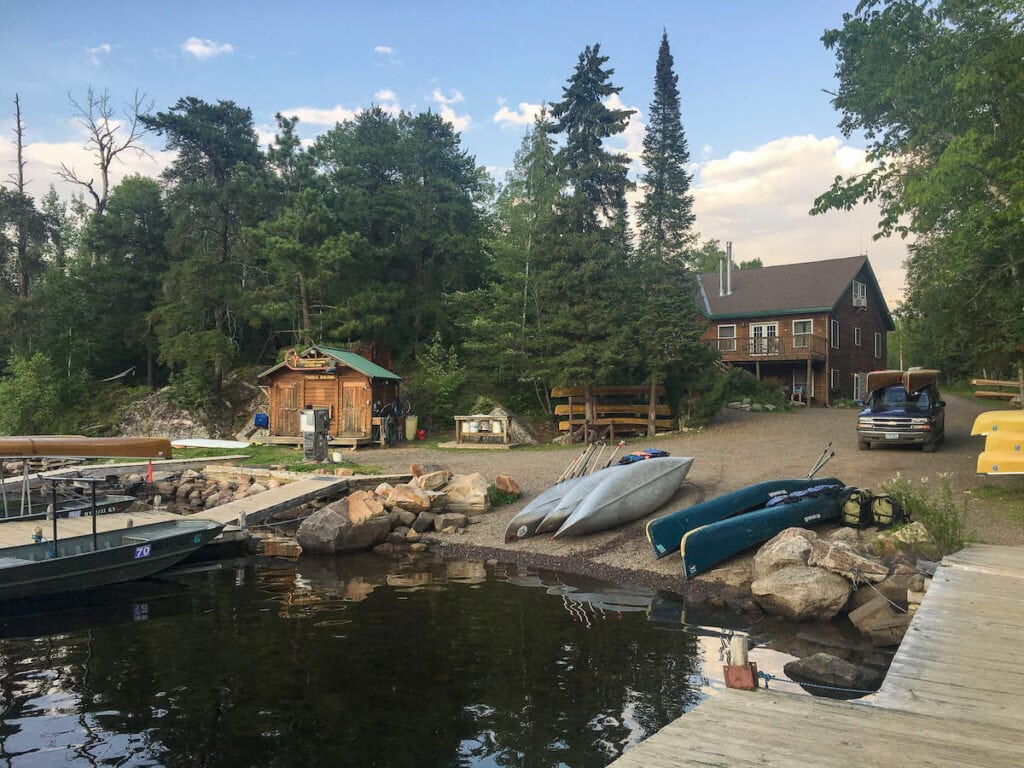
BWCA Permits
Once you’ve decided on where you want to start your trip, you’ll have to secure a BWCA permit. Permits are required for overnight trips from May 1 to September 30 . Walk-up permits are available the day of and the day before your trip, but their availability is not guaranteed. Keep in mind you don’t need to know exactly how many days or how many people are in your party to reserve a permit.
One Boundary Waters permit allows a group of up to 9 people and 4 watercraft to enter the wilderness . You can’t exceed the group limit at any time on water or land. Fees are $16 per adult per trip ($8 per kid per trip), and there’s also a non-refundable $6 reservation fee.
If you plan on fishing, obtain your fishing license before your trip either online or at any gas station/bait shop across the state. If you’re a Minnesota resident, an annual fishing license is $25 or $14 for 72 hours. If you’re a non-resident, it’s $51 annually, $43 for 7 days, or $36 for 72 hours.
The reservation system for Boundary Waters permits opens up at 9 a.m. CT on the last Wednesday of January every year on the BWCA recreation.gov website . If you plan on canoeing outside of the May-September season, you do not need a permit. BWCA canoe rental businesses can also provide permits.
You’ll need to pick up your permits in person at either a Superior National Forest district office or a BWCA outfitter in order to complete the mandatory Leave No Trace & Tread Lightly education session. This is a relatively short video/Q&A session that ensures visitors understand how to minimize their impact in the backcountry and stay safe in the remote wilderness.
While you don’t need a permit to bring a dog into the BWCA, you should bring a current rabies certificate and rabies tag on their collar. Dogs are welcome in the wilderness if they have good voice control, don’t bark or chase wild animals, have experience in a canoe, and are not left unattended . Always be prepared to clean up after your dog.

Boundary Waters Campsites
Boundary Waters campsites are spread throughout the wilderness area and tend to be on wooded shorelines. It’s pretty obvious where most of them are, and they are clearly labeled on BWCA maps. An easy way to tell if a campsite is occupied or not is to look for canoes on the campground shoreline. You can only camp at existing campgrounds in the BWCA and the campgrounds are first-come, first-serve .
It’s a good idea to break camp early and snag the campsite you’d like by early afternoon so you get the one you want. I once slept in and paddled during the afternoon instead and found every campsite was already taken at the lake I had planned to stay on. That meant a much longer day of paddling for me since I had no choice but to canoe on to the next lake and find the next empty campground.
My main consideration when choosing a campground is the view. Do you want to be on a peninsula surrounded by water, in a thickly wooded area, or do you want to make sure you have a great view of the sunset? Take your priorities into account when choosing your spot.
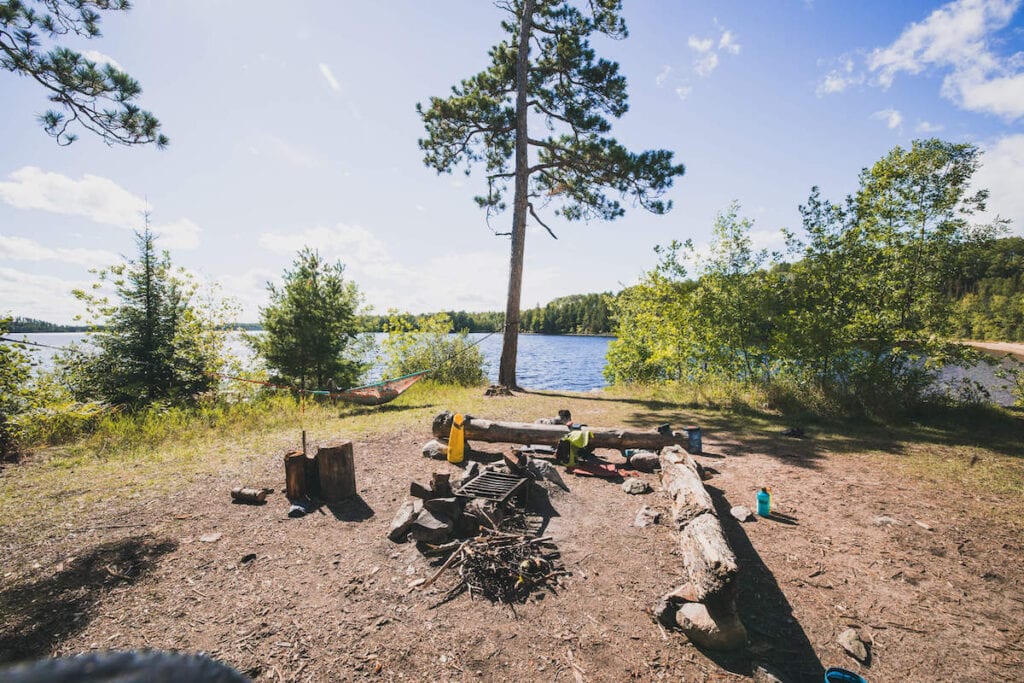
Boundary Waters Canoe Trip Gear
One of the best parts about canoe camping is that you only have to lug your gear on portages.
You can read our 3-day backpacking checklist to get a general idea of what you’ll need. It goes without saying that the Boundary Waters is a remote area; be sure to pack warm clothing and rain gear so you can stay safe in the event of storms, submerged and wet packs, or days or rainy weather.
Shoes for the BWCA
You’ll want good footwear for the Boundary Waters that can deal with water and rugged portages. I recommend water sandals whenever you’re in the canoe or getting in and out. Check our review of the Teva Universal Trail Sandal . These would be a great choice for a BWCA trip.
For portages, you’ll want hiking shoes or boots that have a closed-toe and closed-heel. These will keep your feet and ankles protected while carrying heavy packs and the canoe. Portages in the BWCA are filled with rocks, tree roots, and slippery mud so plan accordingly.
Dry Bags and Canoe Packs
While you can technically use a backpacking pack to carry your gear, using canoe packs from Duluth Pack, Frost River, or Granite Gear has its perks — it’s also what you’ll get from your outfitter if you rent a canoe. You can also invest in a few lightweight dry bags to keep your items dry and separated, like these Sea to Summit Lightweight Dry Sacks .
For a cheaper option, simply line your pack with a garbage bag and arrange your gear inside.
Navigating the Boundary Waters
You’ll need a compass, map, and map case (outfitters will provide these) for a Boundary Waters canoe trip. Fisher Maps , McKenzie , and Voyageur make the best BWCA maps or National Geographic also makes a detailed BWCA Map Pack . There’s little to no cell service in the BWCA, so don’t rely on your phone for navigation and pack or rent a satellite communication device for safety.
To navigate the Boundary Waters, your best bet is to orient yourself using portages, campgrounds, and prominent features of the shoreline like points, islands, bays, etc. It’s normal — and a right of passage — to get pretty confused about exactly where you are since the lakes and islands can make it seem like a maze. Don’t worry, it’s rare for visitors to actually get lost!
Water Gear & Equipment
Aluminum canoes are heavier to carry on portages, but they’ve got one big benefit: they’re bombproof. No need to worry about scraping a rock in these! Kevlar canoes are more fragile and require extra effort when using them, but they’re much lighter to use while paddling and portaging.
You’ll also need a fair amount of gear for your canoe (outfitters will provide all of this): paddles, life jackets , duct tape, sponge and bailer, and cords to tie in your packs. If you’re planning to fish, bring a pole and tackle box. And don’t forget a swimsuit!
Essential Clothing for Paddling
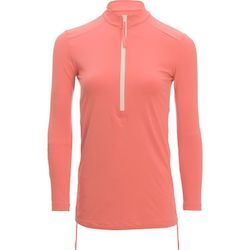
Carve Designs Cruz Rashguard
I prefer wearing a rashguard over sunscreen these days. I own the Cruz in 2 colors and it’s a staple for any water activity because it dries quickly but also keeps you cool, plus the cut is flattering.
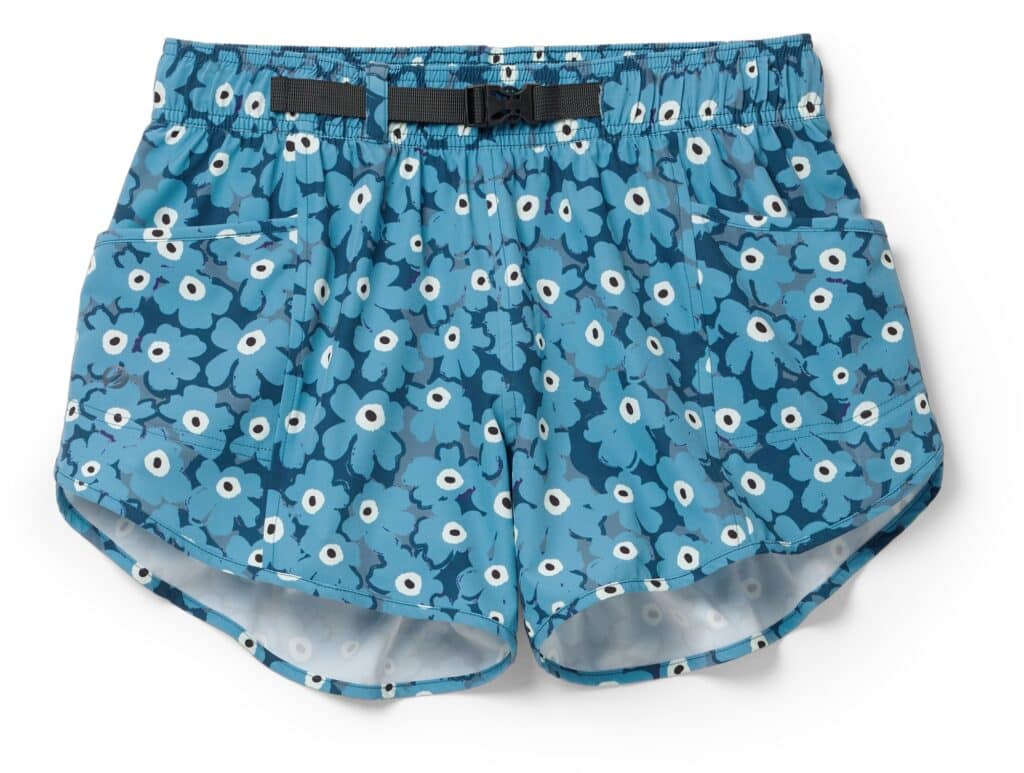
Nani Swimwear Hybrid Explorer Shorts
These shorts are super comfortable, dry really quickly, and come in a bunch of colors and prints. I wear them on all water adventures!

Teva Universal Trail Sandals
Sandals that stay on your feet and can get wet are essential. I like these because they have good grip and can be worn hiking as well, plus they can easily be strapped to your boat when not in use.

Outdoor Research Sunbriolet Hat
You’ll want a wide-brim hat that can get wet and has a chin strap so it stays on in the wind. This Outdoor Research hat is quick-drying, will float if it falls in the water, and comes in a variety of colors.
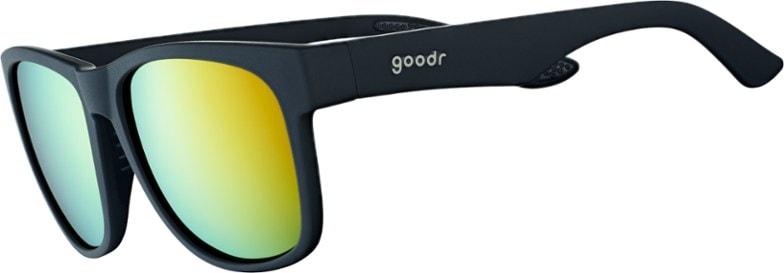
Goodr Polarized Sunglasses
Polarized glasses are best for the reflection of the water. I like to wear budget-friendly sunglasses paddling and I always wear a retainer so I don’t lose them in the water.
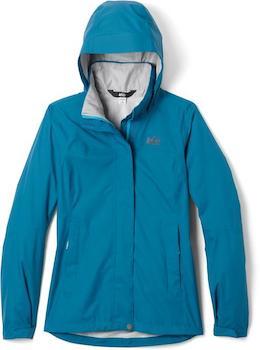
REI Co-op Rainier Rain Jacket
If it’s chilly or windy it can be helpful to have a lightweight rain jacket or windbreaker out on the water with you. I usually pack a jacket like this just in case!
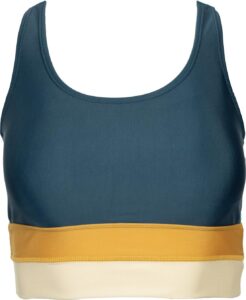
Supportive Swimsuit or Sports Bra
You’ll want a comfortable swimsuit that you can be active in. I like to avoid swimsuits that pull on my neck (like halters) and have been loving Nani Swimwear lately.
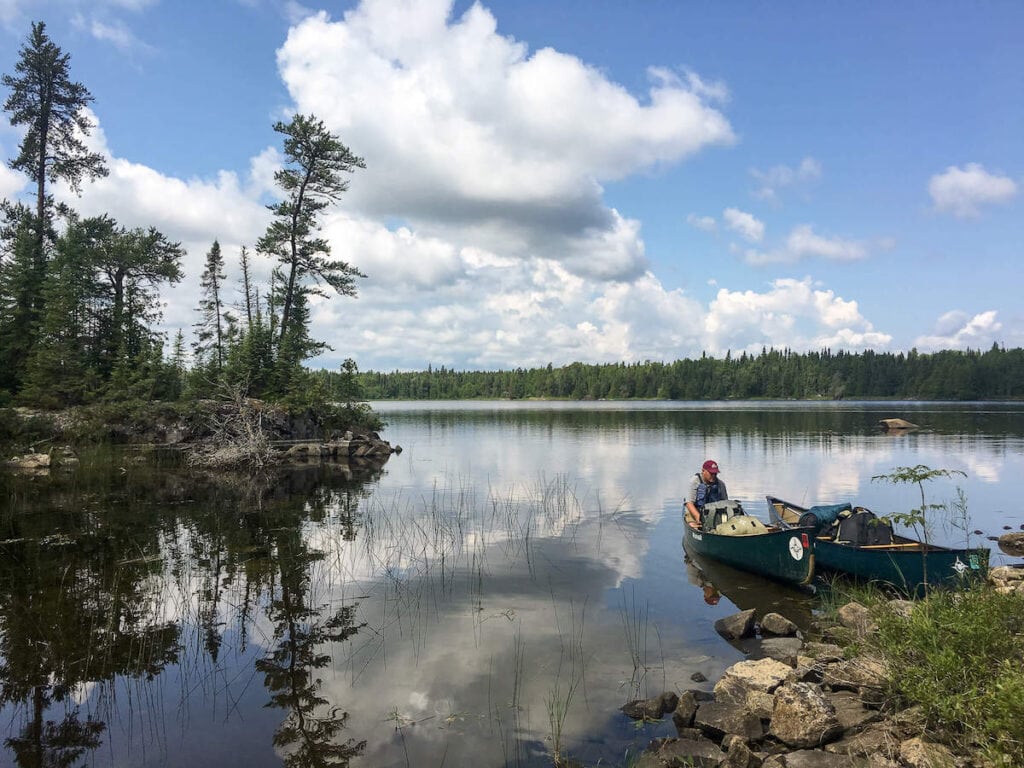
There are bears that live in the BWCA, but they rarely bother people. Most visitors opt to hang their food from a tree instead of bringing a bear canister. To hang your food bag, find a tree limb about 15-20 feet off the ground. Attach a heavy item to the end of your rope and throw it over the branch so that the rope is 4 feet away from the trunk. Now attach your bear sack to the rope, pulley your bag into the air, and tie off your rope. With a little searching, you can usually find a popular tree limb that’s used near each campground.
Water Filtration
Luckily, obtaining water in the Boundary Waters is much easier than most backpacking trips. While old-timers may still drink straight from the lake, it’s safer if you boil or filter the water. Simply paddle out away from your campsite and fill your containers from the lake, then purify or boil the water before using. While I used to drink straight from the lake, it’s not worth risking a Giardia infection.
The Platypus GravityWorks filter system is simple to use without needing to pump it. I’ve also used a Katadyn Hiker Microfilter in the BWCA, too, which I like because you can filter water straight into your water bottle while you’re canoeing.
I recommend filling and treating a 1- to 3-gallon water container when you arrive at your campsite to use for dinner, breakfast, and filling smaller 1-liter Nalgenes for the next day’s paddle.
Fire, Camp Stoves, and Cooking Gear
BWCA campgrounds have a fire pit area that can be used for cooking as long as there isn’t a fire ban in the area. The fires must be small and be put out completely when you’re not in camp. Firewood is available from the surrounding forest, but remember to only take dead and downed wood — live wood doesn’t burn well, anyway. If there is a fire ban, bring a camp stove for your cooking.
Sun Protection
It’s easy to get sunburned on a Boundary Waters canoe trip. Not only are you spending a lot of time out under the sun, but it’s also reflecting upward from your canoe and the water, too! Use sunscreen , a sun hat , and consider UPF clothing to keep the sun at bay.
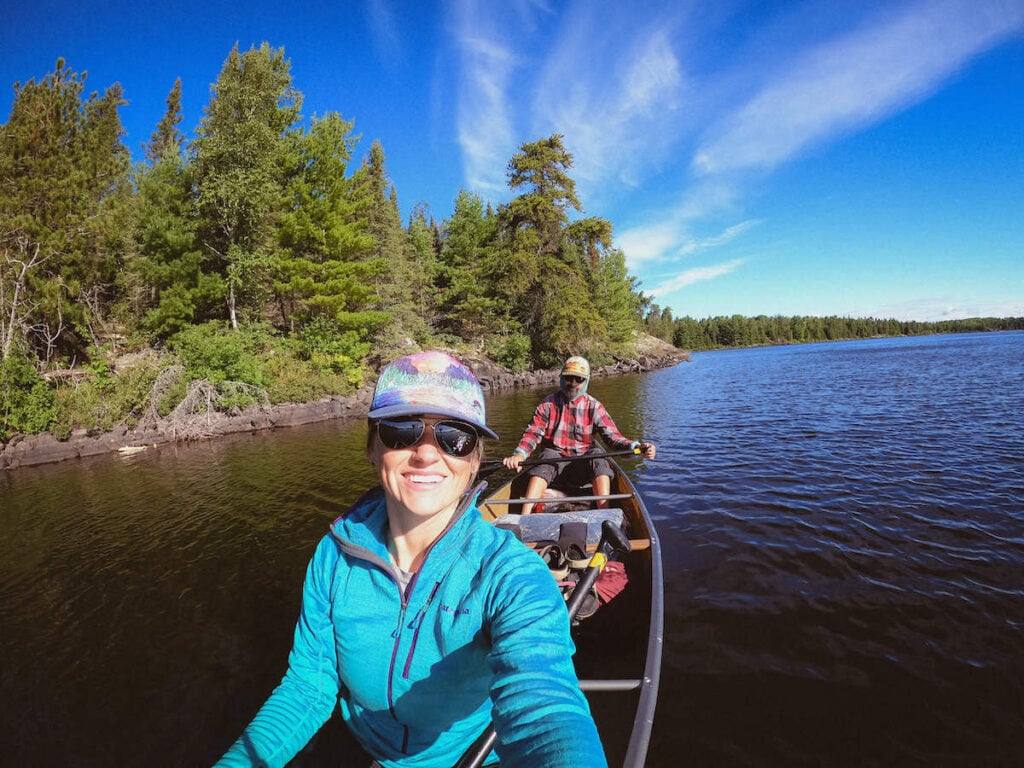
Help Protect the Boundary Waters
The BWCA is a unique, special place. But that doesn’t mean it always will be. Consider supporting the Friends of the Boundary Waters Wilderness to ensure this national treasure stays protected. Proposed copper-sulfide mines like Twin Metals risk contaminating and permanently polluting the Boundary Waters.
Learn more about threats to the BWCA and how you can help protect it by supporting Friends of the Boundary Waters Wilderness .
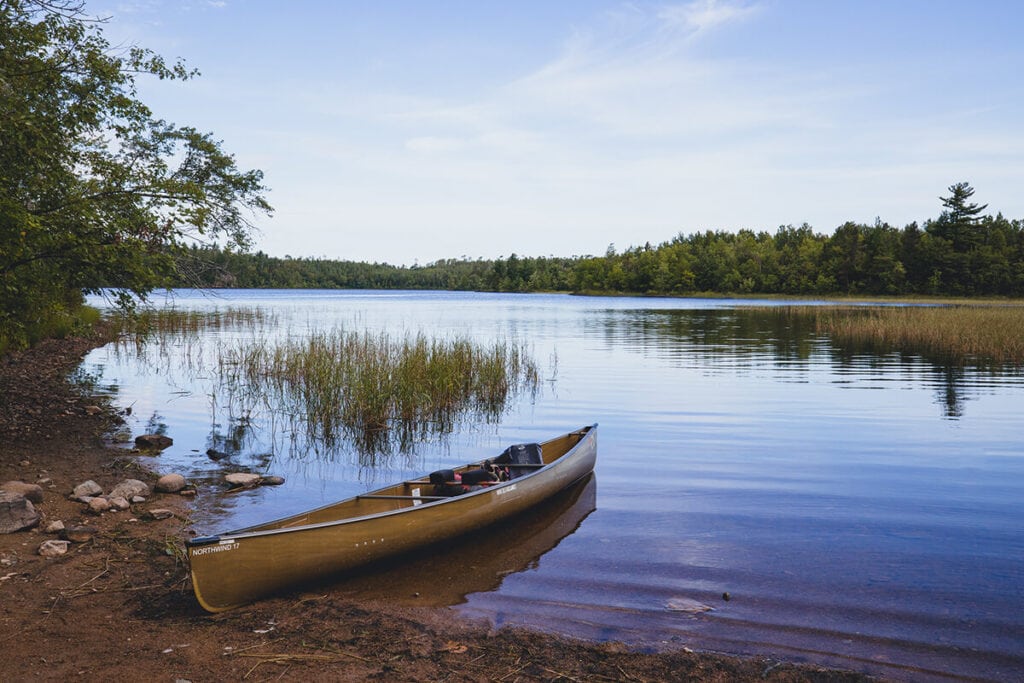
Taking a canoe trip through Minnesota’s Boundary Waters is a trip unlike any other, and thanks to its massive size and undeveloped character, it’s a wilderness you can return to again and again for new adventures. Whether you’re a seasoned paddler or new to canoe camping, the BWCA will not disappoint!
Have you done a Boundary Waters canoe trip or are you planning one? What questions do you still have? Let us know in the comments!
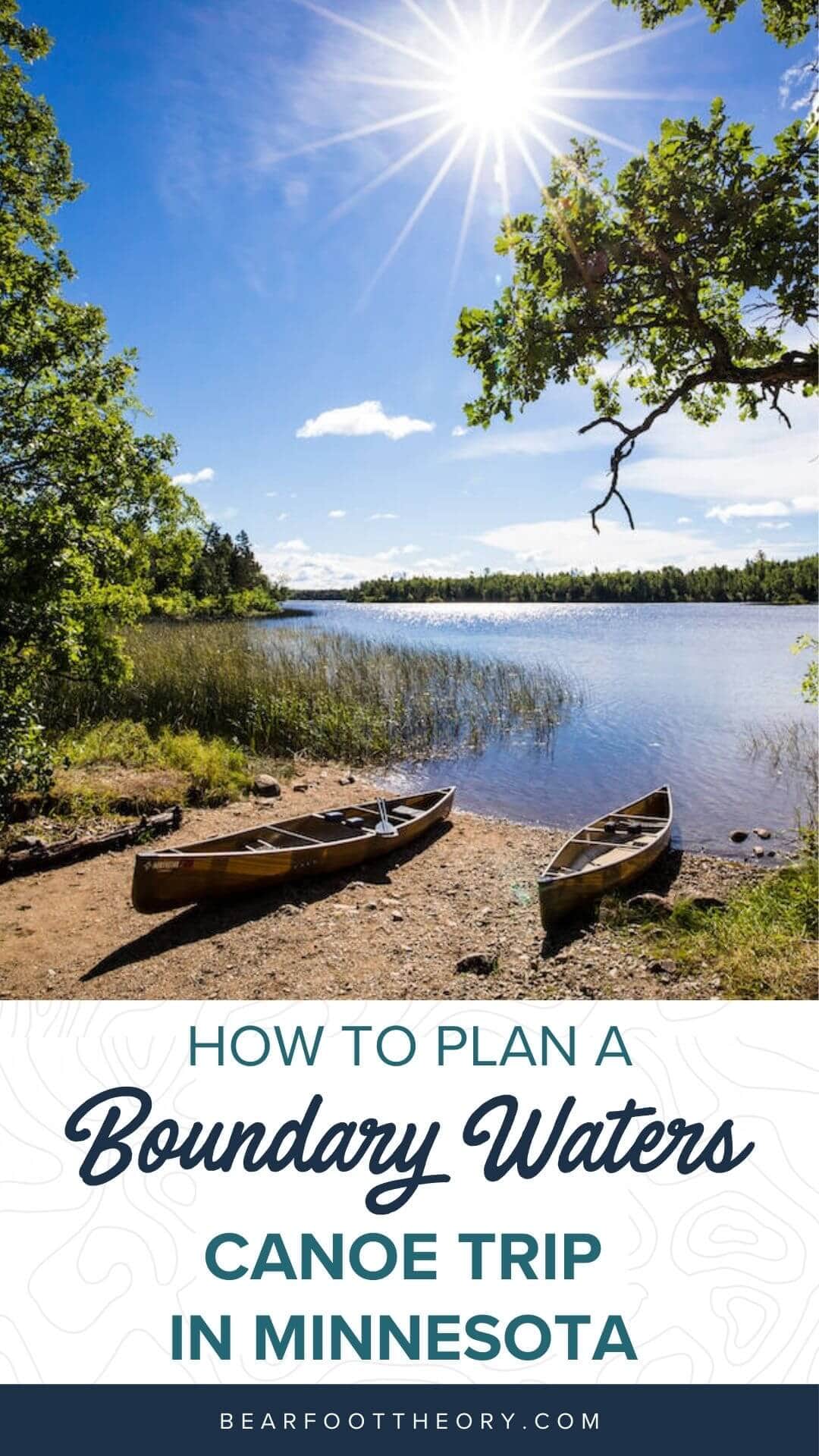
Isak is an outdoor freelance writer that loves traveling through Western public lands in his self-converted van to hike, ski, and find the country’s best used bookstores and coffee shops. When he’s not writing or adventuring, Isak is working on Seek More Wilderness to provide outdoor goods that give back to the outdoors. You can view his writing clips at IsakKvam.com and follow his van adventures on Instagram.
Leave a Reply Cancel reply
Your email address will not be published. Required fields are marked *
Save my name, email, and website in this browser for the next time I comment.
I just got back from the Boundary Waters (6 days, 5 nights in early-mid Sept) and it was amazing. I’m definitely making a trip back sometime, even though I had moments of questioning if i signed up for type 2 fun…. 1) drizzle to rain to soaked tent on night #2, 2) deluge welcomed us to a steep, rocky, slippery campsite, 3) trying to carry a canoe (even part way) on a mile long, level 8.5 portage (and then to find out that was only the second portage of a 3x portage day)…. but then we rewarded with the most beautiful rainbows, silence, starry nights, and disconnection from civilization. Great write up!
That sounds like an adventure!
Amazing clicks of pictures! we have done with same place and its look like a heaven on the earth and we enjoyed our trip. Before visiting this place, we consult with Boundary Waters Catalog about the place and we bought some tools from them. We got some information from some blogs and our trip was amazing.
Hi Eric, thanks for reading & the tip for the Boundary Waters Catalog. Glad you had an awesome trip!

Guided Fishing Trips
Boundary waters motorboat trips.
There are a handful of lakes within the Boundary Waters Canoe Area Wilderness that allow motorboat access. Access is limited to these pristine lakes located within the Wilderness, so day use motor permits are required. If you do not have a permit and are interested in fishing in the BWCA please give us a call!
*All Boundary Waters trips are limited to 3 customers per guide boat. Groups of 4 or more customers will require additional guide boats. Contact for larger group rates.
Full Day (8 hours): 1-2 people: $575 Additional Person: $100
3/4 Day (6 hours): 1-2 people: $500 Additional Person: $75
Shore Lunch (optional): $20 per person
**Permit fee and Portage fee may apply

Ely Area Lakes Trips
We’ll pick you up right from your dock or have one of our guides take you to the lake in the area with the best bite. Whether you want to learn techniques, locations, and know what the fish are doing to better help you catch fish for the rest of your vacation. Cut down the learning curve for the lake your cabin is on, or just want to enjoy a day out on the water catching some fish for a fish fry our guides can accommodate you.
*All Ely Area Lakes trips are limited to 3 customers per guide boat. Groups of 4 or more customers will require additional guide boats. Contact for larger group rates.
1/2 Day (4 hours): 1-2 people: $425 Additional Person: $50
Overnight Motorboat Fishing Trips
Are you looking for more than just a day fishing trip and want the full wilderness experience? How about a fully outfitted overnight fishing trip from a basecamp in the BWCAW. An overnight motorboat Permit is required. These permits are reserved quickly so you should book and secure your dates early.
These trips are fully outfitted with everything that is provided on a day fishing trip. Also included is tents, sleeping bags, sleeping pads, cots, screen tent, all food for meals, along with all other camp gear.
A 2 night minimum reservation is required.
Contact for rates

Meeting times and places will be discussed before your trip.
Deposits: All trips require a $200 deposit per guide, per day. Trips 3 days or longer require a 50% deposit. All deposits are nonrefundable within 30 days of your trip. Trips cancelled more than 30 days before the trip will be charged a 10% cancelation fee. Deposits may be carried to another date if you are able to reschedule.
Payments: Trip balance is due at the end of the trip. Payments can be made with cash, check, Venmo, PayPal, or credit card. A 3.5% fee will be applied to all credit card and PayPal payments.
Gratuity: Gratuities are customary and greatly appreciated.
What we provide:
- Rods and Reels
- Tackle and live bait
- Adult life jackets (youth life jackets are not provided)
- Complementary fish cleaning
What you need to bring:
- Valid MN fishing license (trout stamp if applicable)
- Appropriate clothing for weather conditions
- Sunglasses are recommended
- Food and Beverages (for trips in the BWCAW no glass bottles or aluminum cans allowed. Plastic only!)
- Positive attitude!
Book A Trip
Learn about us.
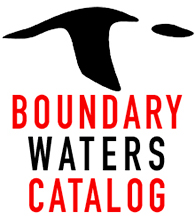
Black Bear Aware Gear
The Forest Service has instituted some new rules about handling food, etc. in the Boundary Waters in relation to Black Bears.
Here is the order on the Superior National Forest site: https://www.fs.usda.gov/detail/superior/notices/?cid=FSEPRD1174552
Bear hanging Illustrations: https://www.fs.usda.gov/Internet/FSE_DOCUMENTS/fseprd501921.pdf
Black Bears are a fact of life in the Superior National Forest that surrounds Ely, Minnesota and the Boundary Waters Canoe Area Wilderness. This is their home. Campers have always been encouraged to use best practices to protect the black bears as well as themselves in regard to food and personal hygiene and personal care products while camping. Now, with the increase in traffic during the last few seasons since the beginning of Covid19, these encouragements and guidelines have changed to be rules that must be followed while traveling in and enjoying the forest. It is more than common sense, it is necessary to abide by precautions that protect canoe campers, bears and the wilderness itself. Hang your food packs and personal care products according to the rules found in the above links or store everything in certified Grizzly Bear Proof containers.
We stock hanging kits as well as Bear Vaults and Ursack equipment .
At the Boundary Waters Catalog and in our Retail Store in Ely, Minnesota, we also have a variety of Bear Aware Accessories and we’ve organized them in an easy to find category for you online.
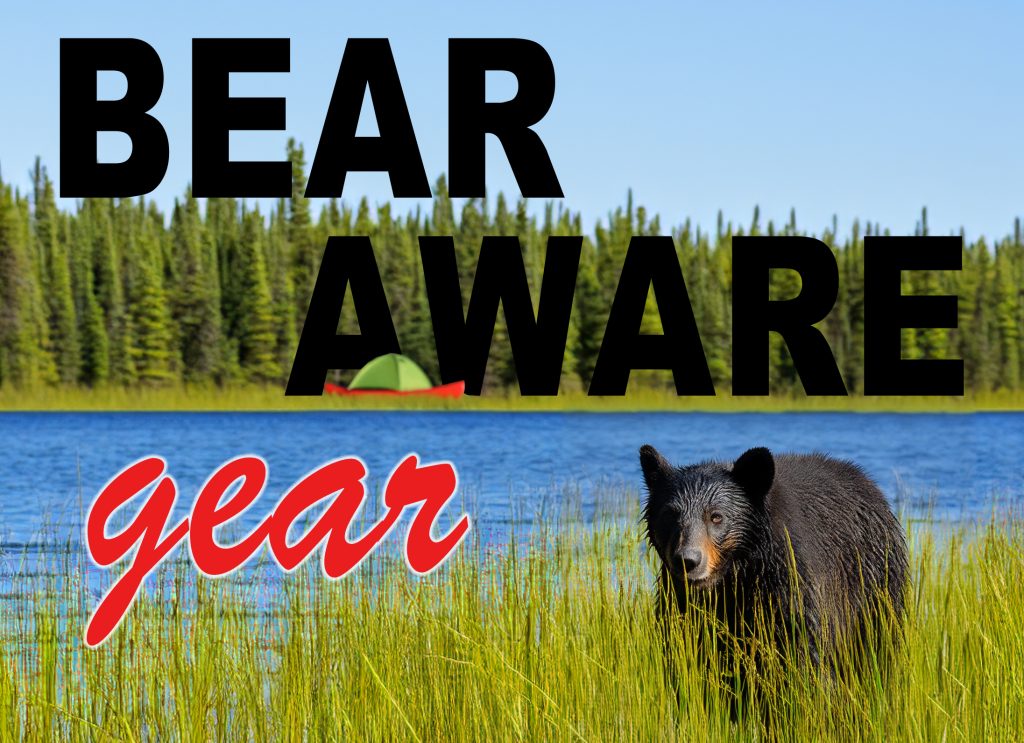
The Outfitting Managers, Drew, Adam and Tim Barton are here for your trip planning, permits and guide reservations. You can click the link below for Trip Planning or call us at 1-800-223-6565. Canoe Trip Planning Here .
Leave a Reply Cancel reply
Your email address will not be published. Required fields are marked *
Post navigation
Watch CBS News
Officials find capsized canoe, submerged body on Lake Agnes
By WCCO Staff
Updated on: May 12, 2024 / 8:06 AM CDT / CBS Minnesota
BOUNDARY WATERS, Minn. — On Friday night, canoeists in the Boundary Water Canoe Area called 911 after locating a capsized canoe and a partly submerged human body on Lake Agnes.
Several officials arrived on scene and were able to recover the body, later identified as a 62-year-old Duluth resident. Officials say that they found a life jacket on scene but that the victim was not wearing it.
The family of the canoeist told officials that the 62-year-old was on a solo camping trip in the area.
The St. Louis County Sheriff's Office is investigating the incident. The DNR has safe boating tips on their website.
READ MORE: Safe tips to follow while out on the water in Minnesota this spring.
- Water Safety
The WCCO Staff is a group of experienced journalists who bring you the content on WCCO.com.
Featured Local Savings
More from cbs news.

Body found during search for missing kayaker in Kandiyohi County

Minor injuries for 3 when driver crashes into house in central Minnesota

Kandiyohi County authorities looking for missing kayaker on Nest Lake
2 rescued from water in western wisconsin; 1 in critical condition.

IMAGES
VIDEO
COMMENTS
Our classic 5-day Boundary Waters Canoe Area Paddle Adventure is the quintessential guided canoe trip. Paddle lightweight Wenonah kevlar canoes and camp in beautiful lakeside campsites. The Boundary Waters lodge based adventure is based out of stunning Wintergreen Lodge on White Iron Lake. From here, you'll enjoy excellent BWCA day trips off ...
Stone Harbor Wilderness Supply. Based in Grand Marais, Stone Harbor Wilderness Supply offers Boundary Waters canoe day trips starting at $150 per person and a four-day guided kayak camping trip on sprawling Saganaga Lake starting at $725 per person. Photo: Britta Bjur // @brittabjur.
The trail-savvy guides of Boundary Waters Guide Service unlock the mysteries of the Boundary Waters by sharing canoeing and camping skills, fishing know-how, local history, and a naturalist perspective. Let us customize your BWCA Wilderness adventure! Our professionally guided camping trips are fully outfitted with the best canoes, camping ...
We offer unforgettable guided canoe trips, day hikes, and other outdoors experiences in the Boundary Waters Canoe Area Wilderness. Border Lakes Tour Company is your go-to guiding service on the Gunflint Trail near Grand Marais, Minnesota! We offer unforgettable guided canoe trips, day hikes, and other outdoors experiences in the Boundary Waters ...
Anticipate spending $40 to $60 per day for a canoe or kayak rental. If you need full outfitting, which includes camping equipment, camp kitchen gear and meals, expect around $115 per person, per day. Finally, a typical five-day fully guided Boundary Waters canoe trip costs $1,100 per person for a group of four.
Moosetrack Adventures Canoe Guides have 10+ years of experience with Boundary Waters guided canoe trips around Ely, MN. Call today 218-365-4106. Call: 218-365-4106 info@ ... Our gear is top-notched and our years of guiding and actually traveling the Boundary Waters Canoe Area Wilderness and Quetico provides our customers with first-hand trip ...
Your go-to BWCA outfitter for canoe trips in Ely, Minnesota since 1984. For over 40 canoe trip seasons we have been one of the leading Boundary Waters outfitters in Ely, Minnesota . We outfit BWCA canoe trips with top-quality gear and meals for both the Boundary Waters Canoe Area Wilderness in northern Minnesota and Quetico Park in Canada.
Boundary Waters Canoe Trips, Guide Services, Kevlar Canoes, Kayaks, Outdoor Gear, and More since 1979. Looking for an authentic, unique vacation experience? Piragis Northwoods Company has been helping guests experience the beauty and solitude of the Boundary Waters Canoe Area for over 40 years.
218-365-3466 or 800-777-8574. To go to Step 6 click here >>. Call Today and set up a trip! 1-218-365-3466. We will walk you through the whole trip planning process - make route suggestions, gear suggestions and even secure all your permits for you.
Overview: Boundary Waters Guide Service provides fully outfitted and professionally guided BWCAW canoe camping and day trip adventures for families and friends. Our trips include knowledgeable, cheerful, local guides. Our guides make the difference. We unlock the mysteries of the Boundary Waters by sharing. paddling and camping skills, fishing ...
A guided Boundary Waters canoe trip that includes sight-seeing, bird watching, photography, and wildlife viewing for white tail deer, wolves, fox, and other animals in the Boundary Waters are popular choices. Guided BWCA canoe trips may also focus on the beauty and peacefulness of the BWCA, viewing its waterfalls, and viewing pictographs.
Bring one of our expert guides along for the fishing experience of a lifetime. Day trips and overnight trips available. Enhance your Canoe Trip with a Boundary Waters Guide. BWCA Guided Fishing Trips, Day Trips, and Customized Trips in Ely, MN since 1979. Guided Canoe Trips.
Lac La Croix. Make a run for the border on this 28-mile, out-and-back route starting at entry point 16. Sprawling Lac La Croix is stunning with its fleet of islands, and along the way you'll touch on the more intimate surroundings of Nina Moose Lake and Lake Agnes. A dozen portages make this route best for intermediate canoe campers.
of Trip to Take. There are many ways to explore the Boundary Waters, but the two most popular modes of travel are hiking and canoeing. Canoeing. Northeastern Minnesota is created for canoeing. This is the best canoe country in the United States, a place where each year thousands of lives are transformed. Hiking.
Offering Fly-In, and Guided Trips. Canoe Trip Route planning available. For the fisherman let us put you on some of the most productive fishing waters in the BWCA. These are the waters we fish ourselves. Outfitting BWCA canoe trip travelers since 1939. Canadian Waters Canoe Trip Outfitters Located in downtown Ely, Minnesota 218-365-3202 or 800 ...
About the Boundary Waters Canoe Area (BWCA) Minnesota and Quetico. Tips On BWCA Canoe Trip Routes. Your trip through the wilderness will only be as good — or as bad — as the route you travel. There is no one route that is best, and there is no one entry point that is best. BWCA Routes can change a great deal over the course of a summer.
The Boundary Waters Canoe Area Wilderness is a special place. Whether you are a beginner or an expert, we can help you have a successful canoe trip in Minnesota's famous BWCA Wilderness. For over 60 years, our family has been pleased to offer you cordial, personal service. Address: 4620 Sawbill Trail, Tofte, MN 55615 Phone: 218-663-7150 www ...
If you're a Minnesota resident, an annual fishing license is $25 or $14 for 72 hours. If you're a non-resident, it's $51 annually, $43 for 7 days, or $36 for 72 hours. The reservation system for Boundary Waters permits opens up at 9 a.m. CT on the last Wednesday of January every year on the BWCA recreation.gov website.
Accessible primarily by canoe, the Boundary Waters in northern Minnesota is one of America's most beautiful and remote adventures. Plan your first trip using this four-day beginner-friendly itinerary. One of the hardest things about planning your first Boundary Waters trip is deciding where to go within the vast preserve's 1,200 miles of canoe routes, 11 hiking trails and approximately 2,000 ...
Step 2: Look over entry points and pick an area you'd like to visit by looking at the overview map of the area. We carry all the trip maps for your Boundary Waters and Quetico Park visit. Purchase maps here. Step 3: Canoe trip outfitters can supply you with complete or partial equipment needs.
There are a handful of lakes within the Boundary Waters Canoe Area Wilderness that allow motorboat access. Access is limited to these pristine lakes located within the Wilderness, so day use motor permits are required. ... Deposits: All trips require a $200 deposit per guide, per day. Trips 3 days or longer require a 50% deposit. All deposits ...
The Outfitting Managers, Drew, Adam and Tim Barton are here for your trip planning, permits and guide reservations. You can click the link below for Trip Planning or call us at 1-800-223-6565. Canoe Trip Planning Here. Food Packs in the Boundary Waters must be correctly hung or packed in certified Bear Proof Containers.
BOUNDARY WATERS, Minn. — Friday night Boundary Water Canoe Area officials called 911 ... The family of the canoeist told officials that the 62-year-old was on a solo camping trip in the area.